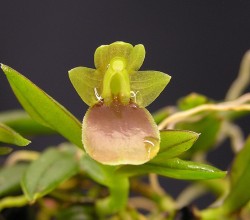

Epidendrum maxthompsonianum Hágsater & Dalström 2008 GROUP Porpax SUBGROUP Porpax
Photo by © Southwestern College Greenhouse Website
TYPE Drawing by © Jimenez, Hágsater & E.Santiago and The AMO Herbario Website

Common Name Max Thompson's Epidendrum [AOS Orchid Judge and Orchid Enthusiast current]
Flower Size .4" [1 cm]
Found in Peru without locational or elevational data as a mini-miniature sized, warm to cool growing epiphyte with simple, canelike, terete, arising from the middle internode of the previous stem carrying 2 to 4, alternate, all along the apical half, articulate, lanceolate, succulent, smooth, green, cuspidate apically, margin entire leaves that blooms on a terminal, arising on a mature growth, occuring only once, sessile, single flowered inflorescence.
"Epidendrum maxthompsonianum belongs to the GROUP Porpax SUBGROUP Porpax , which is characterized by the small, creeping plants with succulent leaves, single flowers from a small spathaceous bract, mostly green with a usually shiny wine-red lip. The species is recognized by the oblique column, the oblong, relatively wide petals, forming a cucullate hood with the dorsal sepals over the column, in natural position, the lip is orbicular. Epidendrum gnomus Schltr. has narrowly triangular, nearly linear petals, outstretched in natural position, and the lip is ovate, somewhat cordate at the base. Epidendrum viridibrunneum Rchb.f. has linear, free petals, with the lip elliptic, the base somewhat cuneate, and elongate calli. Epidendrum mathewsii, which also grows in the region has larger plants but similar sized flowers, with the lip reniform, convex, 3-keeled with entire margins, and the nectary is elongate and does not form a globose vesicle on the underside of the ovary." Hagsater etal 2008
Synonyms
References W3 Tropicos, Kew Monocot list , IPNI ; Icones Orchidacearum 11 Plate 1128 Hagsater 2008 see recognition section; * Icones Orchidacearum 11 Plate 1140 Hagsater & Dalstrom 2008 drawing fide; Icones Orchidacearum 14 Plate 1403 Hagsater & Santiago 2013 See recognition section; Icones Orchidacearum 17(2) Plate 1771 Hagsater & Jimenez 2020 see recognition section
--------------------------------------------------------------------------------------------------------------------------